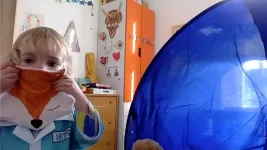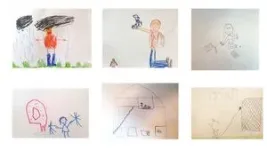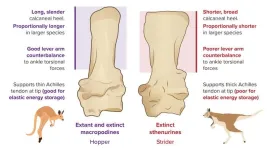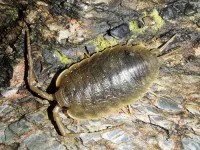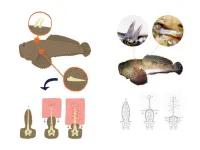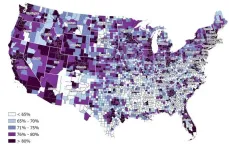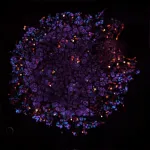(Press-News.org) Children displayed a resilient capacity to continue playing during peak COVID-19, a study has found, even though their options to do so became more limited while under stay-at-home orders.
The research, by academics at the University of Cambridge, interviewed children themselves about their playing habits during the pandemic. Without disputing the consensus that COVID-19 impeded children’s healthy development, it does suggest that they were able to adapt their play habits to their changed circumstances.
Children largely expressed positivity, confidence and optimism about playing, even when they could not see friends or play outside as normal. Play itself, the study says, was therefore “not on lockdown”.
The authors suggest that this more nuanced understanding of what children experienced only emerged after speaking to children themselves. Their study calls for greater inclusion of their perspectives when preparing for future pandemics or other unexpected crises that affect childhood and restrict children’s movements.
Dr Kelsey Graber, who led the Cambridge study, said: “While the pandemic certainly adversely affected children, play didn’t just stop. In fact, in many cases play remained one of the most persistent feature of their lives during so much change. It was one way that children could still be children amid all this adversity.”
The study looked at 15 British children, aged three to 10, during the pandemic, exploring their perspectives on what it was like to play during lockdown. The findings are reported in the journal, Children and Society.
Graber ran playful, Zoom-based interviews with the participants, incorporating activities like show-and-tells with toys and games, drawing, writing and storytelling. The researchers analysed both the children’s verbal responses and important nonverbal cues such as laughter, gestures, nonsense words and silences. The real names of the children have been changed in the report and this article.
About two-thirds of parents reported an increase in children’s play during lockdown. Furthermore, although children were aware of their altered circumstances, lockdown rarely seemed to figure in their thoughts about play.
Some did express frustration about not being able to go to playgrounds or see friends. “No-one knows if Hallowe’en is closed,” one four-year-old told Graber. Occasional signs of pandemic-related lethargy also surfaced. Ellery, aged 10, referred to her dwindling interest in creative writing, explaining: “So many things have been happening and I’m not really in the mood for it every time”.
These sentiments were, however, less common than expected. When asked about how they were staying safe while playing, for instance, children did not reference COVID-19 regulations. Instead, they tended to offer more general safety advice about not running indoors or avoiding broken glass in the park. “Overall, the children focused on what was possible and what they were achieving through their play – not what was missing,” Graber said.
Play persisted as a feature of their lives during the pandemic. Charlie, aged eight, emphasised “finding ways to have fun”, while Liam, nine, welcomed the break from his normal cycle of school and homework for “time to actually play”. Participants described new games they had created or imaginary adventures in elaborate detail. One seven-year-old provided a meticulous account of his action figures’ characters and their adventures together.
Graber also noted multiple instances of spontaneous play during the interviews, which supports existing research that points to play being a persistent and ubiquitous feature of childhood, even in adverse conditions. “You can’t just not play… because it is play,” Liam explained. Similarly, when asked about what she did while stuck at home, five-year-old Ginny replied simply, “Well… I… sort of played a lot”.
Play was also central to children’s communication and comprehension of their experiences during the pandemic, the study found. For example, Olivia, aged three, decided to play vet with stuffed animals during her interview and showed how she was “keeping germs away” from them by imitating the use of a face mask. This was a poignant example of a very young child showing, through play, that she had grasped something different about the wider circumstances she was caught up in, and of what it meant to stay safe and healthy.
Other children acknowledged mental health benefits. The authors suggest that play gave them comfort, confidence and a sense of control. “Play makes my mind grow because I get more creative,” Harry, nine, explained. "I like to play because it helps my imagination," Ian, seven, told Graber.
The study recommends that future crisis planning should go beyond the simple recognition of children’s place in society, as enshrined in frameworks such as the UN Convention on the Rights of the Child, and actively listen to and integrate children’s perspectives and experiences.
“Children’s perspectives do not need to supersede adult judgements made for their benefit in moments of crisis, but when it comes to something so elemental to childhood as play, their input is essential,” Graber said. “We also need a more balanced public narrative about their experiences during the pandemic, especially as we continue to support their ongoing recovery and plan for the future.”
END
Lockdown children played on, study finds, despite being stuck at home
Children displayed a resilient capacity to continue playing during peak COVID-19, even though their options to do so became more limited while under stay-at-home orders. Play was an essential part of how they navigated the pandemic.
2023-06-14
ELSE PRESS RELEASES FROM THIS DATE:
Skipping evolution: some kangaroos didn’t hop, scientists explain
2023-06-14
Extinct kangaroos used alternative methods to their famous hop according to comprehensive analysis from University of Bristol and the University of Uppsala scientists.
Although hopping is regarded as a pinnacle of kangaroo evolution, the researchers highlight that other kinds of large kangaroos, in the not too distant past, likely moved in different ways such as striding on two legs or traversing on all fours.
In the review, published in Alcheringa: An Australasian Journal of Palaeontology, the team shows that there are other ways to be an evolutionary ...
Light pollution confuses coastal woodlouse
2023-06-14
Artificial night-time light confuses a colour-changing coastal woodlouse, new research shows.
The sea slater is an inch-long woodlouse that lives around the high-tide line and is common in the UK and Europe.
Sea slaters forage at night and can change colour to blend in and conceal themselves from predators.
The new study, by the University of Exeter, tested the effects of a single-point light source (which casts clear shadows) and “diffuse” light (similar to “skyglow” found near towns and cities).
While the single light did not interfere with the sea slaters’ camouflage, diffuse light caused them to turn ...
Giving birth outside of working hours in England is safe, suggests study
2023-06-14
A new study suggests that between 2005 and 2014, for almost all births in England, being born outside of working hours did not carry a significantly higher risk of death to the baby from anoxia (lack of oxygen) or trauma, when compared to births during working hours.
The finding runs contrary to an assumed, wider ‘weekend effect,’ with previously reported research suggesting a significantly higher risk of death for births outside of working hours or at weekends.
The current study from City, University of London ...
Brighter nights risk extinguishing glow-worm twinkle
2023-06-14
The bright lights of big cities are wonders of the modern world; intended to help us work, stay safe and enjoy the world around us long after the sun has set. While artificial light has been great for increasing human productivity, some nocturnal animals, and even people, pay a price for this illumination. From increasing the amount of time that predators are active to disrupting migrations, light pollution affects many animals; but how do animals that use their own luminescence to lure food or attract mates fair against this new, brighter background? Female common glow-worms (Lampyris noctiluca) emit a green glow from their abdomen to ...
Meat processing plants: What factors are critical for survival?
2023-06-13
URBANA, Ill. — Meat processing plants in the U.S. have garnered considerable public attention in recent years, often focusing on production and labor issues. The COVID-19 pandemic underscored the vulnerability of large, concentrated plants, as major shutdowns led to reduced output and higher meat prices for consumers.
Policy makers have launched initiatives at the state and federal levels to increase meat processing capacity and industry resilience, often favoring small and medium-sized plants. But little research exists to determine what factors make plants more likely to succeed. A new study from the University of ...
CHOP researchers develop universal MHC molecules that can be produced rapidly at scale
2023-06-13
Philadelphia, June 13, 2023— Class I major histocompatibility complex (MHC-I) proteins play an essential role in the immune system of all jawed vertebrates. The MHC-I displays peptide fragments of proteins from within the cell on the cell surface, “presenting” them to the immune system, which is constantly scanning the body for foreign or toxic antigens. When foreign peptides are identified, they trigger a cascade that allows cytotoxic T cells to eliminate intruders. This process has been exploited in the development of both vaccines ...
Peptide from venomous fish toxin controls lung inflammation in mice
2023-06-13
A molecule found in the venomous toadfish Thalassophryne nattereri has proved capable of controlling lung inflammation and could be the basis for a more effective asthma drug. The research was supported by FAPESP and conducted by scientists at Butantan Institute in São Paulo, Brazil. An article describing the results is published in the journal Cells.
A welter of fish species live in freshwater, seawater and a mixture of the two, and some of them are venomous. They have spines or stingers connected to venom glands, which ...
Residents in 'digital deserts' have fewer health care options
2023-06-13
Residents in rural counties with limited access to high-speed internet cannot take advantage of increasingly popular online health services.
A new study by the University of Cincinnati highlighted disparities in access to digital technology that could widen the gap in access to health care. The study found that socially vulnerable communities in the United States face more barriers to adequate health care, live in areas with fewer health care resources and have less access to high-speed internet.
The study was published in the journal Mayo Clinic Proceedings: Digital Health.
The Biden Administration announced this year it will invest $73 million in outreach ...
Different genes are expressed at different stages during pregnancy, according to scientists
2023-06-13
We have a good understanding of how a woman’s external features can change during pregnancy, but scientists know surprisingly little about what biological changes occur internally.
A new Northwestern Medicine study, published June 5 in the journal Frontiers in Immunology, provides data about immune cells and biological changes (gene expression) in pregnant people at multiple timepoints before and during pregnancy. Using RNA sequencing and computational methods to estimate proportions of different activated types of immune cells in blood the team of scientists showed how pregnancy induces progressive changes in the maternal ...
USC Stem Cell’s journey towards 1,000 mini-kidneys begins with $1 million from KidneyX
2023-06-13
To help patients in need of transplants, artificial kidneys would have to function like their natural counterparts, but they wouldn’t necessarily have to look like them. With a new $1 million prize from the Kidney Innovation Accelerator, or KidneyX, a team of USC Stem Cell scientists led by Nils Lindström in collaboration with Leonardo Morsut are on a quest to build a kidney that resembles the real thing in function, but not in form.
“Nature has taught us that kidneys can come in an ...
LAST 30 PRESS RELEASES:
Numbers in our sights affect how we perceive space
SIMJ announces global collaborative book project in commemoration of its 75th anniversary
Air pollution exposure and birth weight
Obstructive sleep apnea risk and mental health conditions among older adults
How talking slows eye movements behind the wheel
The Ceramic Society of Japan’s Oxoate Ceramics Research Association launches new international book project
Heart-brain connection: international study reveals the role of the vagus nerve in keeping the heart young
Researchers identify Rb1 as a predictive biomarker for a new therapeutic strategy in some breast cancers
Survey reveals ethical gaps slowing AI adoption in pediatric surgery
Stimulant ADHD medications work differently than thought
AI overestimates how smart people are, according to HSE economists
HSE researchers create genome-wide map of quadruplexes
Scientists boost cell "powerhouses" to burn more calories
Automatic label checking: The missing step in making reliable medical AI
Low daily alcohol intake linked to 50% heightened mouth cancer risk in India
American Meteorological Society announces Rick Spinrad as 2026 President-Elect
Biomass-based carbon capture spotlighted in newly released global climate webinar recording
Illuminating invisible nano pollutants: advanced bioimaging tracks the full journey of emerging nanoscale contaminants in living systems
How does age affect recovery from spinal cord injury?
Novel AI tool offers prognosis for patients with head and neck cancer
Fathers’ microplastic exposure tied to their children’s metabolic problems
Research validates laboratory model for studying high-grade serous ovarian cancer
SIR 2026 delivers transformative breakthroughs in minimally invasive medicine to improve patient care
Stem Cell Reports most downloaded papers of 2025 highlight the breadth and impact of stem cell research
Oxford-led study estimates NHS spends around 3% of its primary and secondary care budget on the health impacts of heat and cold in England
A researcher’s long quest leads to a smart composite breakthrough
Urban wild bees act as “microbial sensors” of city health.
New study finds where you live affects recovery after a hip fracture
Forecasting the impact of fully automated vehicle adoption on US road traffic injuries
Alcohol-related hospitalizations from 2016 to 2022
[Press-News.org] Lockdown children played on, study finds, despite being stuck at homeChildren displayed a resilient capacity to continue playing during peak COVID-19, even though their options to do so became more limited while under stay-at-home orders. Play was an essential part of how they navigated the pandemic.
